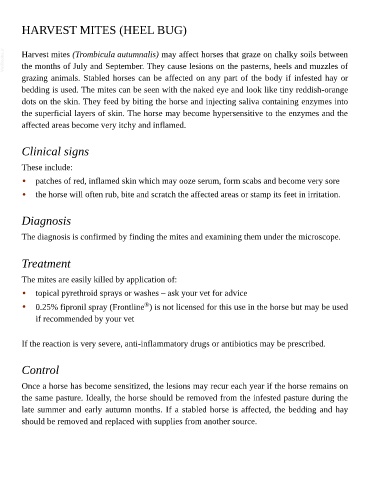Page 848 - The Veterinary Care of the Horse
P. 848
HARVEST MITES (HEEL BUG)
VetBooks.ir Harvest mites (Trombicula autumnalis) may affect horses that graze on chalky soils between
the months of July and September. They cause lesions on the pasterns, heels and muzzles of
grazing animals. Stabled horses can be affected on any part of the body if infested hay or
bedding is used. The mites can be seen with the naked eye and look like tiny reddish-orange
dots on the skin. They feed by biting the horse and injecting saliva containing enzymes into
the superficial layers of skin. The horse may become hypersensitive to the enzymes and the
affected areas become very itchy and inflamed.
Clinical signs
These include:
• patches of red, inflamed skin which may ooze serum, form scabs and become very sore
• the horse will often rub, bite and scratch the affected areas or stamp its feet in irritation.
Diagnosis
The diagnosis is confirmed by finding the mites and examining them under the microscope.
Treatment
The mites are easily killed by application of:
• topical pyrethroid sprays or washes – ask your vet for advice
®
• 0.25% fipronil spray (Frontline ) is not licensed for this use in the horse but may be used
if recommended by your vet
If the reaction is very severe, anti-inflammatory drugs or antibiotics may be prescribed.
Control
Once a horse has become sensitized, the lesions may recur each year if the horse remains on
the same pasture. Ideally, the horse should be removed from the infested pasture during the
late summer and early autumn months. If a stabled horse is affected, the bedding and hay
should be removed and replaced with supplies from another source.

